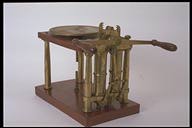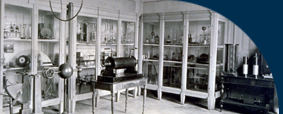|
OUR COLLECTION OF SCIENTIFIC INSTRUMENTS
PHYSICS OF THE AERIFORM, PNEUMATICS |

 |
Double-barrelled air-pump |
 |
Macchina pneumatica a due stantuffi |
| Subject: pneumatics |
Settore: pneumatica |
| Number of catalogue: 39 |
Numero di inventario: 39 |
| Engraved on the front cover enclosing the rack and pinion mechanism: "C. Wolf in Firenze" |
Frontalmente, sul coperchio che racchiude il meccanismo a cremagliera: "C. Wolf in Firenze" [inciso] |
| c. 1854 |
Periodo di costruzione: 1854 circa |
| Mahogany, brass, frosted glass |
Materiali utilizzati: Mogano, ottone, vetro smerigliato |
| 408 X 248 X 450 [mm] |
Dimensioni: 408 X 248 X 450 [mm] |
| |
|
This beautiful pneumatic machine bears Corrado Wolf's engraved signature: he was from Florence and was one of those instrument-makers that Leopoldo Nobili, the famous physicist from Reggio, most appreciated. The instrument was included in the collection of Urbino probably in the fifth decade of the 19th century, being already noted in a catalogue of the year 1862. The peculiar feature of this machine is that it is provided with Belli-Babinet's tap, which is a device created by the Italian physicist Giuseppe Belli (1791-1860) in 1827 and by the French physicist Jacques Babinet (1794-1872) in 1828, who probably worked independently. With this device significant progress was made in the technique for the production of vacuum because the flaw of the rarefaction system (which did not permit the opening of the outlet valves of the pistons) was avoided with a tap crafted with more than one inlet or outlet opening. The tap allowed for the accumulation of the remaining air into only one barrel, until the air was able to lift up the valve by itself and be ejected. |
Questa bella macchina pneumatica reca incisa la firma del costruttore fiorentino Corrado Wolf, uno degli artefici di fiducia del fisico reggiano Leopoldo Noboli. Lo strumento, entrò nella collezione urbinate probabilmente negli anni cinquanta del secolo XIX, essendo già presente in un inventario del 1862. La particolarità di questa macchina è che essa è dotata del rubinetto Belli-Babinet, un dispositivo ideato, probabilmente indipendentemente l'uno dall'altro, dal fisico italiano Giuseppe Belli (1791-1860) nel 1827 e dal fisico francese Jaques Babinet (1794-1872) nel 1828. Con esso si ebbe un significativo progresso nella tecnica per la produzione del vuoto perchè si ovviava al difetto dell'inefficienza del sistema di rarefazione per basse pressioni (che non permetteva l'apertura delle valvole di sfogo degli stantuffi) con un rubinetto a più vie che permetteva di accumulare tutta l'aria rimanente in un sol corpo di tromba fino a che essa non era in grado di sollevare la valvola ed essere espulsa. |
| |
|
Description: The pneumatic machine is fixed into a robust rectangular mahogany base; the machine consists of two cylinders or barrels, of a crank with two handles and of four brass columns. The columns support a second mahogany base, on which there is a brass plate covered with a sheet of frosted glass (upon which the glass bell is placed). A brass tube with a pin directly connects the plate with the left barrel, which can be linked to the right barrel through Belli-Babinet's tap. This device, which is entirely made of brass and is cone-shaped to favour its air-tightness, is placed between the two barrels. It has five holes and can be moved manually in two different positions through two engraved marks with the numbers "1" and "2": the former of which is for direct connection between the two barrels and the latter for the connection between the barrels and the plate. At its base each barrel has a tap of the same form as Belli-Babinet's; both taps are connected and moved by a system of hinged levers controlled by the rotation of the two-handled crank. The crank, in turn, controls a cog-wheel, which meshes with two rack rods fixed to the pistons. |
Descrizione: Su un robusto basamento rettangolare in mogano è montata la macchina pneumatica costituita da due cilindri o corpi di tromba, una manovella a due manici e quattro colonne d'ottone; queste ultime sostengono sulle loro sommità un secondo basamento in mogano ove è fissato un piatto d'ottone (per riporvi la campana di vetro) ricoperto di una lastra di vetro smerigliato. Un condotto d'ottone munito di chiavetta collega il piatto direttamente con il solo cilindro di sinistra. Questo può essere messo in comunicazione con il cilindro di destra tramite il rubinetto Belli-Babinet. Questo dispositivo, completamente d'ottone e di forma conica per favorire la tenuta, è posizionato tra i due cilindri. Esso ha cinque fori e può essere manovrato manualmente in due posizioni differenti tramite l'incisione di due tacche segnate con i numeri "1" e "2", rispettivamente per la connessione diretta tra i due cilindri e per quella tra i cilindri e il piatto. Ogni cilindro ha sotto la sua base un rubinetto della medesima forma di quello Belli-Babinet; entrambi i rubinetti sono connessi e messi in movimento da un sistema di leve snodate, comandate dal moto rotatorio della manovella a due manici. Questa comanda a sua volta una ruota dentata su cui ingranano due aste a cremagliera fissate agli stantuffi. |
| |
|
Function: By manually turning the crank, the pistons become subject to an alternated motion, as one is lifted up and draws air in, while the other at the same time is lowered and forces air out of the barrel. The mechanism of rarefaction and of emission is activated through the two mobile taps that alternately open and close the connection between the two barrels, thereby favouring the emission of air out of the two barrels. |
Funzionamento: ruotando meccanicamente la manovella, si imprime un moto alternativo agli stantuffi per cui l'uno, alzandosi, aspira l'aria mentre contemporaneamente l'altro, abbassandosi, la costringe ad uscire dal cilindro. Il meccanismo di rarefazione ed espulsione viene espletato mediante i due rubinetti mobili che aprono e chiudono alternativamente la connessione tra i due cilindri, favorendo contemporaneamente la fuoriuscita dell'aria dai cilindri. |
| |
|
Bibliography: Ganot [1855], p. 162; Bernardini, Mantovani, Vetrano [1987], pp. 125-126; Bellodi, Brenni [1994], pp. 88-89. |
Bibliografia: Ganot [1855], p.162; Bernardini, Mantovani, Vetrano [1987], p. 125-126; Bellodi, Brenni [1994], pp. 88-89. |
|
|
|

